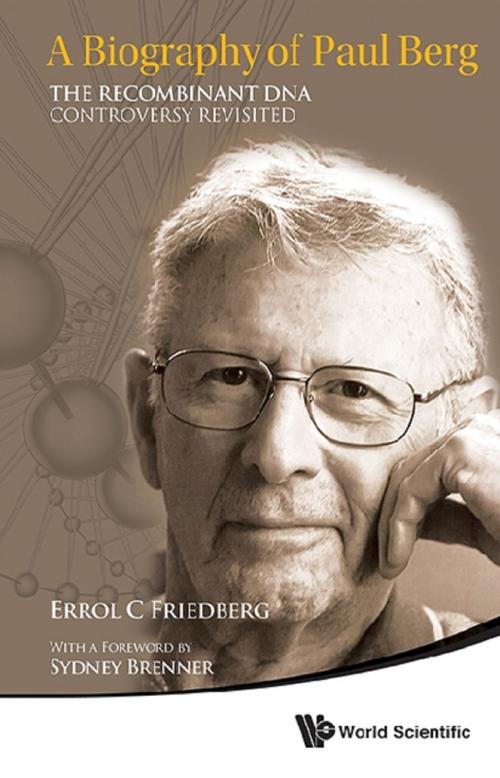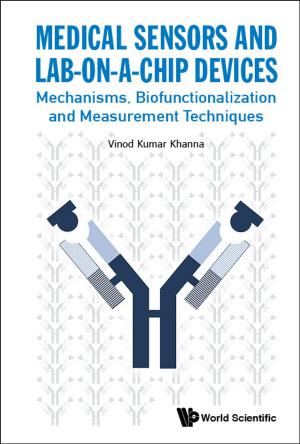A Biography of Paul Berg
The Recombinant DNA Controversy Revisited
Biography & Memoir, Reference, Nonfiction, Science & Nature, Science, Biological Sciences| Author: | Errol C Friedberg | ISBN: | 9789814569064 |
| Publisher: | World Scientific Publishing Company | Publication: | June 17, 2014 |
| Imprint: | WSPC | Language: | English |
| Author: | Errol C Friedberg |
| ISBN: | 9789814569064 |
| Publisher: | World Scientific Publishing Company |
| Publication: | June 17, 2014 |
| Imprint: | WSPC |
| Language: | English |
With a Foreword by Sydney Brenner (Nobel laureate in Physiology or Medicine, 2002)
This biography details the life of Paul Berg (Emeritus Professor at Stanford University), tracing Berg's life from birth, in 1926, to the present, with special emphasis on his enormous scientific contributions, including being the first to develop technology that led to gene cloning science. In 1980, Berg received a Nobel Prize in chemistry for this work.
In addition to his contributions in the research laboratory, Berg orchestrated and oversaw a historic meeting at Asilomar, California that centered on a threatening controversy surrounding the perception by some of the harmful potential of recombinant DNA technology. This meeting did much to forestall this controversy and to put in place the regulation of recombinant DNA work, thus putting fears to rest.
The recombinant DNA controversy was a historic outcome of the discovery of gene cloning. Notably, it represented a paramount example of scientific foresight and due diligence by the scientific community, rather than by regulatory entities in the United States and many other countries. The ultimate acceptance of gene/DNA cloning led to a new era of modern biology that thrives to the present.
This book is aimed primarily at scientists and those in training. The book strives to simply provide information for the general reader, but is not specifically tailored for a general reading audience.
While many books cover the recombinant DNA controversy, none have satisfactorily addressed this historic period and are often contradictory about the many who's, where's, and why's involved. Additionally, the great majority of these were written by non-scientists. This biography of Paul Berg provides access to numerous archived letters and documents at Stanford University not previously addressed, and to the chronology of events as recalled and documented by him, as well as other key personalities, many of whom were interviewed.
Contents:
-
Part I:
- Growing Up in Brooklyn
- The Essential Paul Berg
- College — and World War II
- Western Reserve University
- Copenhagen
-
Part II:
- Washington University, St. Louis
- Discovering Transfer RNA
- Stanford University — and Its Refurbished Department of Biochemistry
- Transcription and Translation: New Directions
-
Part III:
- Making Recombinant DNA — The First Faltering Steps
- Making Recombinant DNA — A Major Breakthrough
- EcoRI Restriction Endonuclease — A Major Breakthrough
- “Coincidence is the Word We Use When We Can't See the Levers and Pulleys”
- Yet Another Stanford Contribution
-
Part IV:
- An Historic Meeting in Hawaii
- The Recombinant DNA Controversy
- A Momentous Gordon Research Conference
- Making Recombinant Molecules with Frog DNA
- The Controversy Heats Up
- Asilomar II
- The Dissenters: A Different Point of View
- The Aftermath
- Legislative and Revisionist Challenges to Recombinant DNA
- Asilomar II — Lessons Learned
-
Part V:
- The Nobel Prize in Chemistry
- Commercializing the Technology
- Life Goes on
- The “Retirement” Years
- Public Policy Issues — and Other Interests
- Personal Challenges
Readership: Researchers, graduate students, undergraduates in life sciences, medicine and chemistry and interested lay public.
With a Foreword by Sydney Brenner (Nobel laureate in Physiology or Medicine, 2002)
This biography details the life of Paul Berg (Emeritus Professor at Stanford University), tracing Berg's life from birth, in 1926, to the present, with special emphasis on his enormous scientific contributions, including being the first to develop technology that led to gene cloning science. In 1980, Berg received a Nobel Prize in chemistry for this work.
In addition to his contributions in the research laboratory, Berg orchestrated and oversaw a historic meeting at Asilomar, California that centered on a threatening controversy surrounding the perception by some of the harmful potential of recombinant DNA technology. This meeting did much to forestall this controversy and to put in place the regulation of recombinant DNA work, thus putting fears to rest.
The recombinant DNA controversy was a historic outcome of the discovery of gene cloning. Notably, it represented a paramount example of scientific foresight and due diligence by the scientific community, rather than by regulatory entities in the United States and many other countries. The ultimate acceptance of gene/DNA cloning led to a new era of modern biology that thrives to the present.
This book is aimed primarily at scientists and those in training. The book strives to simply provide information for the general reader, but is not specifically tailored for a general reading audience.
While many books cover the recombinant DNA controversy, none have satisfactorily addressed this historic period and are often contradictory about the many who's, where's, and why's involved. Additionally, the great majority of these were written by non-scientists. This biography of Paul Berg provides access to numerous archived letters and documents at Stanford University not previously addressed, and to the chronology of events as recalled and documented by him, as well as other key personalities, many of whom were interviewed.
Contents:
-
Part I:
- Growing Up in Brooklyn
- The Essential Paul Berg
- College — and World War II
- Western Reserve University
- Copenhagen
-
Part II:
- Washington University, St. Louis
- Discovering Transfer RNA
- Stanford University — and Its Refurbished Department of Biochemistry
- Transcription and Translation: New Directions
-
Part III:
- Making Recombinant DNA — The First Faltering Steps
- Making Recombinant DNA — A Major Breakthrough
- EcoRI Restriction Endonuclease — A Major Breakthrough
- “Coincidence is the Word We Use When We Can't See the Levers and Pulleys”
- Yet Another Stanford Contribution
-
Part IV:
- An Historic Meeting in Hawaii
- The Recombinant DNA Controversy
- A Momentous Gordon Research Conference
- Making Recombinant Molecules with Frog DNA
- The Controversy Heats Up
- Asilomar II
- The Dissenters: A Different Point of View
- The Aftermath
- Legislative and Revisionist Challenges to Recombinant DNA
- Asilomar II — Lessons Learned
-
Part V:
- The Nobel Prize in Chemistry
- Commercializing the Technology
- Life Goes on
- The “Retirement” Years
- Public Policy Issues — and Other Interests
- Personal Challenges
Readership: Researchers, graduate students, undergraduates in life sciences, medicine and chemistry and interested lay public.















